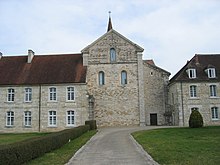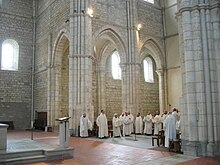History
The abbey was built in 1136 at the instigation of the Archbishop of Besançon, Anseric de Montréal, and of Renaud III, Count of Burgundy, about 5 kilometres distant from an existing settlement of hermits. The initial community of monks were from Cherlieu Abbey, and Acey was therefore of the filiation of Clairvaux. The new foundation grew rapidly and had soon built six granges. In 1184 it was able to found a daughter house, Pilis Abbey in Hungary (dissolved in 1526). At the end of the Middle Ages it fell into the hands of commendatory abbots.
Its location on the boundary of the Free County of Burgundy and the Duchy of Burgundy caused it to be involved in warfare in 1435 and 1477, in 1569 during hostilities with Protestants and in 1595 under King Henry IV of France.
The 17th century brought more destruction. In 1650, 6 bays of the nave of the abbey church collapsed over a length of 30 metres. In 1683 the abbey burnt down. Between 1745 and 1771 extensive restoration took place.
The French Revolution brought its dissolution in 1790. Various uses of the premises followed, after the restoration of the monarchy mostly religious, until in 1873 the buildings were again occupied by a Cistercian community, in the form of Trappist monks from Aiguebelle Abbey. Between 1900 and 1910 the church was restored. In 1938 the community was again raised to the status of abbey. It is the only Cistercian foundation in Franche-Comté still used for its original purpose.
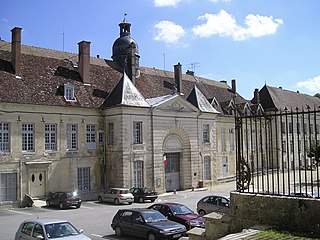
Clairvaux Abbey was a Cistercian monastery in Ville-sous-la-Ferté, 15 kilometres (9.3 mi) from Bar-sur-Aube. The original building, founded in 1115 by Bernard of Clairvaux, is now in ruins; the present structure dates from 1708. Clairvaux Abbey was a good example of the general layout of a Cistercian monastery. The abbey has been listed since 1926 as a historical monument by the French Ministry of Culture.

Cîteaux Abbey is a Catholic abbey located in Saint-Nicolas-lès-Cîteaux, south of Dijon, France. It is notable for being the original house of the Order of Cistercians. Today, it belongs to the Trappists.

Orval Abbey is a Cistercian monastery founded in 1132 in the Gaume region of Belgium and is located in Villers-devant-Orval, part of Florenville, Wallonia in the province of Luxembourg. The abbey is well known for its history and spiritual life but also for its local production of the Trappist beer Orval and a specific cheese.

Pontigny Abbey, the church of which in recent decades has also been the cathedral of the Mission de France, otherwise the Territorial Prelature of Pontigny, was a Cistercian monastery located in Pontigny on the River Serein, in the present diocese of Sens and department of Yonne, Burgundy, France. Founded in 1114, it was the second of the four great daughter houses of Cîteaux Abbey. It was suppressed in 1791 in the French Revolution and destroyed except for the church. In 1843 it was re-founded as a community of the Fathers of St. Edmund. In 1909 it passed into private ownership. In 1941 it became the mother house of the Mission de France, a territorial prelature.
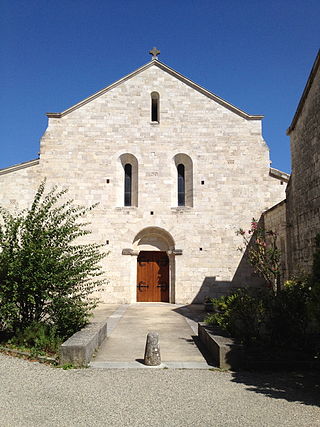
Aiguebelle Abbey is a Trappist monastery situated in the communes of Montjoyer and Réauville in the département of Drôme, on the borders of the Dauphiné and of Provence, France.

Thoronet Abbey is a former Cistercian abbey built in the late twelfth and early thirteenth century, now restored as a museum. It is sited between the towns of Draguignan and Brignoles in the Var Department of Provence, in southeast France. It is one of the three Cistercian abbeys in Provence, along with the Sénanque Abbey and Silvacane, that together are known as "the Three Sisters of Provence."

Trois-Fontaines Abbey was a Cistercian abbey in the present commune of Trois-Fontaines-l'Abbaye in the French department of Marne, in the historic province of Champagne.

La Trappe Abbey, also known as La Grande Trappe, is a monastery in Soligny-la-Trappe, Orne, France. It is known for being the house of origin of the Trappists, to whom it gave its name.

Vaux-de-Cernay Abbey was a Cistercian monastery in northern France (Île-de-France), situated in Cernay-la-Ville, in the Diocese of Versailles, Yvelines.

Chimay Abbey is an abbey in Wallonia in the city of Chimay, Hainaut, Belgium.

Melleray Abbey was a Cistercian monastery, founded about the year 1134. It was situated in Brittany, Diocese of Nantes, in La Meilleraye-de-Bretagne in the vicinity of Châteaubriant.

Aulps Abbey is a former Cistercian monastery located at an altitude of 810 metres in the village of Saint-Jean-d'Aulps in the Aulps Valley, Haute-Savoie, French Alps. It is 7 km from Morzine, 25 km from Thonon and 60 km from Geneva.
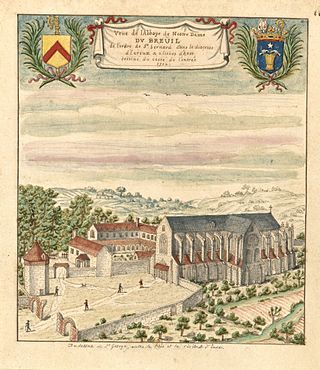
Le Breuil-Benoît Abbey is a former Cistercian abbey in Marcilly-sur-Eure in the Eure department of Normandy, France. It is located around 10 km to the west of Dreux, on the left bank of the river Eure.

Igny Abbey or Val d'Igny Abbey is a Cistercian abbey located in Arcis-le-Ponsart, Marne, France. It was founded in 1128 for Cistercian monks, dissolved in 1791 during the French Revolution, re-established in 1876 for Trappist monks, destroyed in 1918, reopened in 1929 for Trappist nuns and modernised in 2008–12 to accommodate three or four pre-existing communities.

Cherlieu Abbey is a former Cistercian monastery in the commune of Montigny-lès-Cherlieu in Haute-Saône, France, about 37 kilometres west-north-west of Vesoul and about 6 kilometres south-east of Vitrey-sur-Mance in the Forest of Cherlieu.

Morimondo Abbey is a former Cistercian monastery located at Morimondo, a few kilometers south of Abbiategrasso in the Metropolitan City of Milan, Lombardy, northern Italy. The surviving structure is Romanesque and Gothic. It was founded in 1134 as a daughter house of Morimond Abbey near Dijon, from which it took its name.
This page is based on this
Wikipedia article Text is available under the
CC BY-SA 4.0 license; additional terms may apply.
Images, videos and audio are available under their respective licenses.
